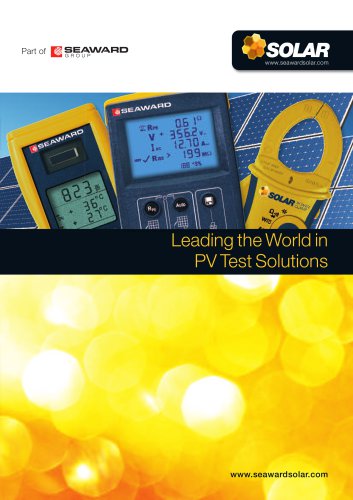 Website:
SOLAR SEAWARD
Website:
SOLAR SEAWARD
Group: SEAWARD Group
Catalog excerpts

PV System Measurement - FACTS From Seaward What is solar irradiance? Solar irradiance is the light intensity of the sun. The electrical output of PV panels depends on the intensity of the sunlight falling onto the PV module surface. Specifically, it is the sunlight falling perpendicular to the PV module which is of most interest when characterising the electrical output of a PV system, this is know as inplane irradiance. Why measure solar irradiance? The electrical output will vary significantly with changes in the level of in-plane irradiance. Solar PV panel manufacturers quote the electrical output at standard test conditions (STC) with an irradiance level of 1000W/m2. Therefore, when commissioning a PV system, it is necessary to measure the level of irradiance at the same time as testing its electrical output, to know whether it is working to its potential under the existing irradiance levels. If the electrical output is different from the manufacturers’ quoted values, it must be determined whether this is due to a fault in the PV installation, or simply because irradiance was different from STC. For example, a PV module with a rated short circuit current of 8A is delivering a measured current of 4A. If the irradiance at the time of measurement is 500W/m2 (i.e. 50% of the STC value), we have demonstrated that the reduced electrical output is due to a reduced irradiance level and not a fault in the system. Simultaneous measurement and recording of irradiance, open circuit voltage (Voc) and short circuit current (Isc) is required for the PV Array Test Report for BS EN 62446 and MCS (see DTI Guide to the Installation of PV Systems). How is solar irradiance measured? Energy from the sun is spread over a wide spectrum, from ultraviolet to infrared. Solar irradiance meters that assess PV modules must therefore have a spectral response close to that of a PV module in order to measure ‘true irradiance’ as a PV system would. There are two irradiance measurement methods defined and accepted by International Standards covering the performance measurement of PV systems: 1. Pyranometer High precision, high cost instruments using thermal sensors in a glass dome. 2. PV Reference Cell Effectively a small scale version of a PV module, having the same response to solar energy. Temperature compensation ensures accuracy is not affected by heat. Other devices such as light meters, lux meters or devices using photo diode sensors do not have the same spectral response as a PV module. They do not compensate for temperature and are likely to introduce significant measurement errors if used for solar PV applications. They are not suitable for use on PV syste
Open the catalog to page 1
SEAWARD Experts in what we do www.seawardsolar.com ► Comparison between Survey 200R and Lux meter ► What is SolarLinkTM? Measuring both irradiance and electrical output at the same time presents a problem. The irradiance meter must be next to the PV modules on the roof while electrical measurements are made inside the building. The solution - Seaward SolarLink™ SolarLink™ uses wireless technology to transfer real time measured data from the Survey 200R to the PV150. The irradiance value from the Survey 200R is shown on both devices. True irradiance and electrical output of the PV string can...
Open the catalog to page 2
&SOLAR From Seaward www.seawardsolar.com With Solarlink™ and USB download, the PV150 is the only way to assess the performance and safety of PV systems with complete traceability.
Open the catalog to page 3
From Seaward PV System Electrical Commissioning Tests The PV150 enables simple, safe and fast testing of photovoltaic systems to BS EN 62446 and various state regulations as shown below. 5.4.2 Earth Continuity Where protective earthing and/or equipotential bonding conductors are fitted, such as bonding of the array frame, the continuity should be tested. 5.4.5.2 PV String Short Circuit Current Short circuit of current is measured to ensure correct installation and operation of each PV string. Measured values should be compared with expected values. For systems with multiple identical...
Open the catalog to page 4All SOLAR SEAWARD catalogs and technical brochures
-
PV150
3 Pages
-
SolarSurvey 100/200R Series
3 Pages




